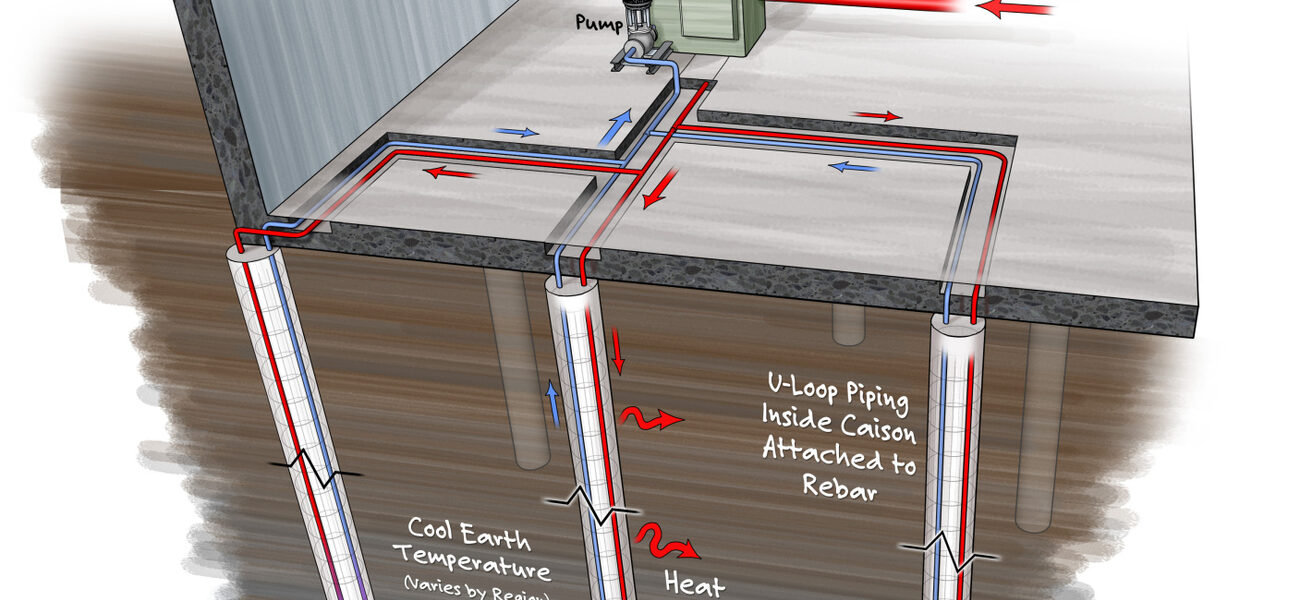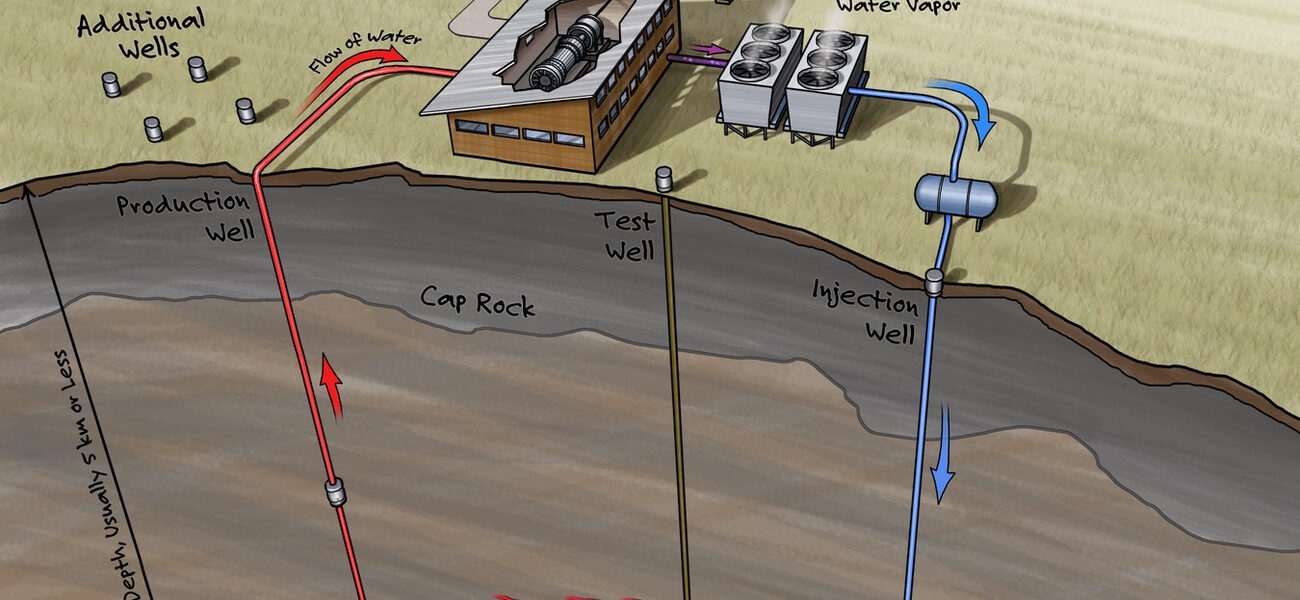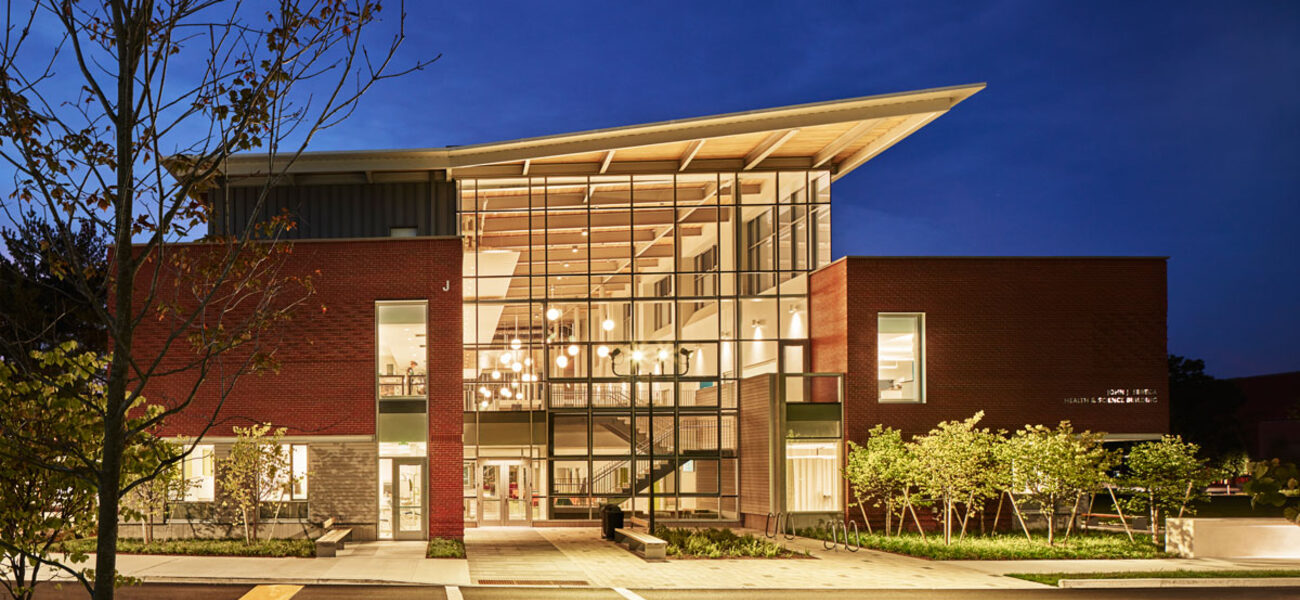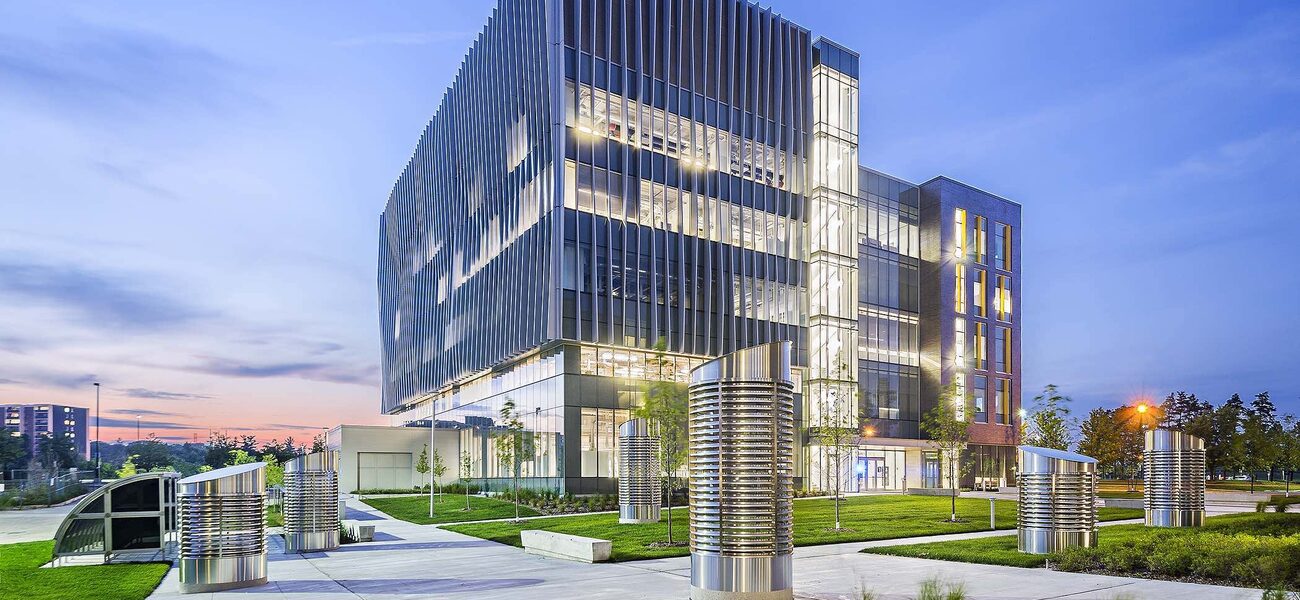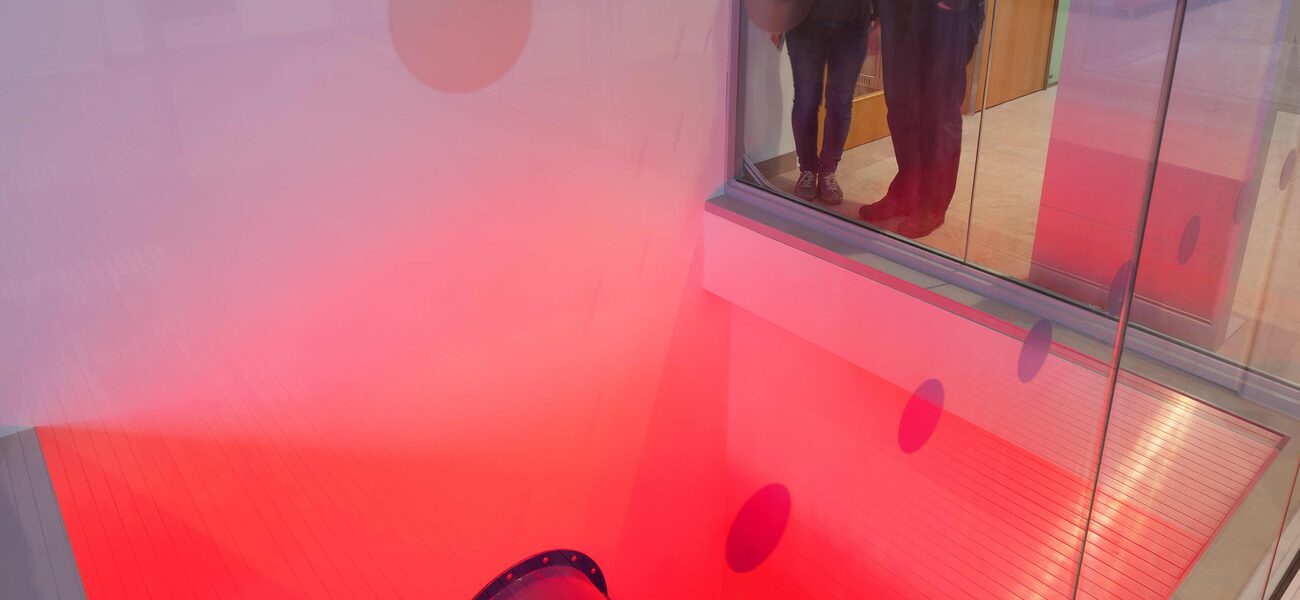Geothermal heating and cooling exchange systems are proving to be a leading technology for achieving zero net energy consumption in cold climates. Geoexchange systems (also known as “geothermal heat pumps”) reduce energy consumption by using the earth to store heat and greatly improve HVAC efficiency. Using a network of closed-loop tubes buried deep underground, geoexchange systems require extensive planning, soil testing, and proper load design to function as intended, especially in energy-intensive lab environments. But when used with other strategies, they can play a significant role in reducing a facility’s HVAC-related energy use and carbon footprint.
Ultra-sustainable lab facilities like the Health and Science Building at Bristol Community College, University of Toronto’s Environmental Science and Chemistry Building, and the Smithsonian Environmental Research Center’s Mathias Laboratory (which is tracking LEED Platinum) all demonstrate the viability of using geothermal exchange systems in high performance labs.
“From a primary heating and cooling standpoint, geoexchange is probably the leading technology for achieving the low level of energy consumption you need so you can add renewables and other technologies to get to zero net energy,” says Scott Foster, principal at the Chicago office of Affiliated Engineers, Inc. Zero net energy is attained when the total amount of energy used by a building annually is roughly equal to the amount of energy created on-site.
When applied correctly, geoexchange technology offers the lowest cost option for primary heating and cooling, even after the increased costs for installation are factored in. They also have the lowest carbon footprint and least environmental impact of any competing technology.
Geothermal Energy vs. Geoexchange
Geoexchange and geothermal energy systems are not the same thing, though geoexchange systems are frequently referred to as being geothermal. True “geothermal energy” systems, which are much more common in Europe than in the U.S., don’t use electricity. They extract heat from deep within the earth to create steam and generate electricity using power plant turbines and other systems. While it requires deeper, more expensive drilling and more complex systems, geothermal power generation is considered highly sustainable compared to other technologies.
By contrast, “geoexchange systems” (alternately known as “geothermal heat pumps” or “ground source heat pumps”) use the stable temperature of the ground to store heat energy so it can be pulled back out and distributed into a building with minimal electricity. Depending on latitude, the soil temperature more than 20 feet underground is roughly constant year-round—regardless of changes in surface temperature—warming slightly as it absorbs solar radiation. Geoexchange heat pumps exploit this dynamic with closed-loop, fluid-filled pipes buried underground which extract ground heat from the earth in the winter (for heating) and transfer it back in the summer (for cooling).
“There are significant differences between true geothermal energy systems and geoexchange heat pump systems,” says Michael Walsh, senior mechanical engineer and principal at Boston-based R.G. Vanderweil Engineers. “In fact, ASHRAE still refers to ground source heat pumps as geothermal in their latest design manual for geoexchange systems. So obviously, there’s still some confusion around the terminology even among industry professionals.”
A vertical geoexchange system consists of a series of boreholes drilled next to or under the building (usually more than 300 feet deep) that contain a network of closed-loop pipes circulating water (or glycol, depending on climate). A heat pump uses the principles of refrigeration to regulate heat across the underground system using minimal electricity, while an HVAC distribution system circulates hot or cold air to the building as required by season.
Importance of Testing and Design
One of the challenges with geoexchange systems in colder climates is ensuring that enough heat is rejected from the system during the warmer months so that heat that is pulled back out in the colder months doesn’t permanently alter the underground soil temperature.
“One of the first things you want to understand is how to balance the energy loads,” says Foster. “If you’re in a heating-driven climate and you don’t put enough heat in to the system in the summer months when it’s warm, you will eventually start cooling the earth around the system year-round.”
Soil more than 20 feet deep naturally maintains a stable temperature and is slowly, passively heated by solar radiation. That soil essentially serves as an energy battery that is heated or cooled by the geoexchange well pipes. If the building is constantly pulling heat out of the ground—without putting enough back to offset the heating needs—the geoexchange system will eventually cool the underground soil temperature around the well field; how far and how much it cools would depend on the size of the system and how much heat is not returned.
“We recently looked at a project in Newfoundland, which is essentially a heating-driven climate year-round. Over the course of a few years, the fluid underground got cooler and cooler until the geoexchange system wouldn’t work anymore. So, you really have to look at balancing the energy loads based on how much you’re going to pull back out of it in the winter,” says Walsh.
While there are different configurations for underground heat exchange wells, large commercial, industrial, and academic buildings typically bore vertical holes a minimum of 300 feet deep adjacent to the supported site. Key considerations include properly sizing and routing the piping to minimize horsepower demands on the heat pump; whether to use glycol for freezing resistance (which makes the system less efficient); and conducting an early site soil analysis to understand the ground’s unique heat exchange properties.
“Optimizing your drilling is an important part of designing a geoexchange system,” says Foster. “That means getting a test-well drilled that tells you what the geology is so you can use that information to make economically smart decisions on how deep to drill, versus how much to spread out your well field.”
Hybrid Systems and Holistic Strategies
The John J. Sbrega Health and Science Building at Bristol Community College in Fall River, Mass., was designed to be a zero net energy lab that combines a hybrid geoexchange system with a 3.2 megawatt solar array on top of a canopy over 800 parking spaces that serves the entire campus. As an academic chemistry and biology teaching building, proper design of the HVAC system was a major consideration.
“We looked at the energy model and saw that, due to the building’s HVAC requirements, it was going to consume more than half of the energy produced by the new solar array,” says James Moses, principal at Big Bend Studio and former director at Sasaki. “So we took that as an opportunity to do things better and aim for zero net energy and also zero net carbon. That’s where geoexchange came into the picture.”
To reduce air demand, 13 of the building’s 17 chemical fume hoods are filtration fume hoods that recycle internal air to minimize HVAC lab exhaust loads. Combined with indoor air quality sensors for occupant peace of mind, this allowed for the elimination of an air handling unit, less duct work, and a reduction in floor-to-floor heights, all of which helped the project come in on budget for a high-performance lab.
“We knew that we needed to optimize the geothermal exchange system because sizing it for both heating and cooling would have blown our budget and required the well field to be huge,” says Moses.
The building’s hybrid system allows the full heating load to be handled by the geoexchange field, while the cooling load and shoulder seasons are taken care of by a combination of both geo and air exchange, which allows the ground temperature to balance out.
“A common mistake with a project like this is to think there is a silver bullet. But you really need to have a holistic approach for this kind of model to work. A lot of effort goes into balancing loads and getting everything right in combination with other systems, especially in a lab environment,” says Moses.
Models of Sustainability
When the University of Toronto Scarborough set out to make its new Environmental Science and Chemistry Building a model of urban sustainability, geothermal exchange was identified from the outset as a key design feature. This was crucial because, while most geoexchange wells are located under land or water adjacent to the building they serve, the footprint of the campus in Scarborough, Ontario, necessitated drilling the well field directly below the building prior to construction. The instructional lab facility now supports research on climate change, urban groundwater pollution, and rising sea levels, among other environmental issues.
The facility’s geoexchange well consists of 66 holes drilled 600 feet below the building. This geoexchange system is combined with a unique “earth tube” system that draws fresh air in through six large concrete tubes that heat or cool it below the frost line as necessary before it enters the system. Additional fresh air is added along the HVAC path to provide 100 percent ventilation to the administrative wing, with geoexchange handling about 25 percent of the building’s heating and cooling loads.
Likewise, when the Smithsonian Environmental Research Center set out to make the Mathias Laboratory in Edgewater, Md., as environmentally sustainable as possible, a geoexchange system was installed to help the building target a LEED Platinum rating and serve as a test case for using geoexchange as part of a new central utility plant master plan that could serve all of the buildings in their campus research core.
“We were a little apprehensive at first because we had no experience doing a geothermal system, and we were plugging it into a chemical and biological lab with high energy demands,” says Steven Groh, project manager at the Smithsonian Environmental Research Center.
The system features a geothermal exchange field under an adjacent meadow with 250 closed-loop wells that are 435 feet deep and provide primary heating and cooling exchange for the lab’s HVAC system. A 352-kilowatt solar panel array provides more than 15 percent of the building’s annual electricity needs.
“We’re now three years down the road, and the results of our trend reports have been great. Currently, we’re planning on extending the geothermal field to the administration building and looking at ways it can be incorporated into our master plan for other facilities on campus,” says Groh.
By Johnathon Allen


